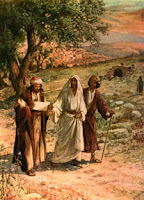
This is the second in a series of 'Guest Articles' by Paul Green of Virginia.
Carl Heinrich Bloch - born on May 23, 1834, Copenhagen, Denmark.
In 1865 Bloch was assigned to illustrate the life of Christ, in a series of 23 paintings for the King's Praying Chamber in Frederiksborg Castle Chapel, Denmark. It would take Bloch almost fourteen years to complete the commission. The resulting paintings would define his career and would be complemented by eight altar pieces and an outstanding series of 78 etchings, influenced by Rembrandt’s depictions of Christ.
Following the premature death of his wife in 1886 he was left with the responsibility of his eight children. The grief and stress proved to be too much and he died of stomach cancer in 1890 at the age of 56. In addition to his Biblical art, Bloch was renowned as a genre and portrait painter and served under various positions at the Royal Academy of Fine Arts.
Bloch’s painting
'Marriage At Cana' (above) depicts the reaction of the servers as they realize the water has been transformed into wine. The figure of Christ looks on from a distance from his seat at the wedding table. The masterly use of lighting bathes Jesus and the wedding guests in bright daylight as one of the servers in the foreground points to the source of the miracle.

The etching
'Writing in the Sand' (1889) depicts a thoughtful Jesus in stark contrast to the accusers of the woman caught in adultery. Their desire for justice under the law which requires the stoning to death of the woman is countered by Jesus calmly writing in the sand. Jesus becomes the focus of attention as some reflect on their own actions and turn away.
Text © Paul Green 2008.
I'd like to add a brief footnote to Paul's article.Like many artists, Carl Bloch struggled with doubts about his own abilities. Later in his career, these doubts were replaced by an intense conscientiousness regarding what he considered to be his calling, which was to paint scenes from the life of Christ.
During his short life, Bloch produced around 250 paintings, but considered his alter paintings to be his most important work!
For more of Bloch's Bible Art,
click here.Other articles by Paul Green:
Henry Ossawa TannerHerbert Gustave Schmalz




